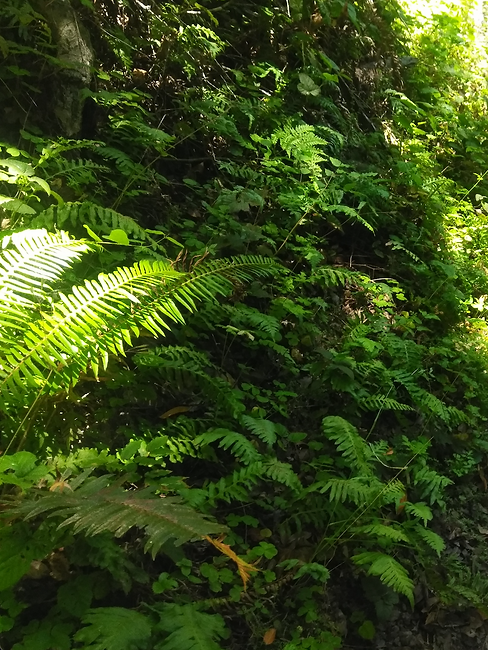Allopolyploidy = Bioinformatic Challenges
Ferns are ideal systems for the study of allopolyploids: hybrids derived from unreduced diploid rather than haploid gametes, resulting in a polyploid genome with double the normal chromosome number derived from two different species. The high degree of hybridization and polyploidy in ferns is striking, but also makes them notoriously difficult to identify with cryptic morphologies and complicates studying their genetic data due to multiple gene copies or recombined gene copies from hybridization as well as a rich history of genome duplication.
My own work has characterized allopolyploid hybridization in the fern genus Polypdium s.s. using next generation target-capture DNA sequence data. This work resulted in the development of the SORTER pipeline that processes target-capture data at several scales:
-
Sorting through paralogous variants of targeted sequences, if present, via similarity clustering with USEARCH, resulting in alignments with a higher orthologue accuracy across alignments.
-
Phasing orthologue alignments into their respective diploid haplotypes using SAM-Tools phasing
-
Phasing hybrid sequences into progenitor sequence sets based on sequence similarity to non-hybrid samples representing potential progenitors. This allows allopolyploid or homoploid hybrids to be analyzed in phylogenetic software to identify putative progenitor species.
Published in Systematic Botany (2023):
Mendez-Reneau, J., Gordon Burleigh, J. and Sigel, E.M., 2023. Target capture methods offer insight into the evolution of rapidly diverged taxa and resolve allopolyploid homeologs in the fern genus Polypodium ss. Systematic Botany, 48(1), pp.96-109.






Identifying Cryptic Species and Hybrids
In concert with morphology, ecology, and island biogeography, SORTER helped guide and establish stable groupings for the identification of subspecies in the endemic hawaiian fern, Polypodium pellucidum (Kaulf.), that exhibits a perplexingly plastic range of morphological variants.
We discovered that these morphological variants correspond to both 'pure' and hybrid lineages representing intermediate morphologies. We found that lineages are structured according to unique ecologies, island distributions, elevations, and growth habits, providing invaluable resources for conservation and biodiversity management as well as advancing our understanding of species evolution and diversification via ecosystem, evolutionary, and hybridization dynamics.
Published in American Journal of Botany (2024):
Mendez-Reneau, J. I., J. L. Richards, J. Hobbie, E. Bollich, N. J. Kooyers, and E. M. Sigel. 2024. Lineage diversification and rampant hybridization among subspecies explain taxonomic confusion in the endemic Hawaiian fern Polypodium pellucidum. American Journal of Botany e16379. https://doi.org/10.1002/ajb2.16379
Disentangling a Cryptic Allopolyploid Commonly used for Biochemical Products
Polypodium vulgare (L.) is currently known as a broadly distributed Eurasian fern, that is the type species for the larger Polypodiaceae family that has a rich taxonomic history of taxa that have been refined into several distinct genera, species and hybrids over time. For my dissertation work I used SORTER to understand the evolution of P. vulgare across Eurasia.
Polypodium vulgare is an allotetraploid hybrid, meaning it has two genome copies derived from two distinct diploid progenitor species. My work revealed that P. vulgare across Europe and Asia share the circum-boreal parent species P. sibiricum, but have alternative parents represented by P. glycyrrhiza in Europe and South Africa and by P. fauriei in Japan and Eastern continental Asia, clearly showing that these are two distinct species with different geographic distributions.
Extracted compounds found in P. vulgare are studied and used across a broad range of pharmacological, cosmetic, and agrochemical applications. It's crucial for these industries to have a clear understanding of the evolutionary lineages and genomes comprising their products, as this genetic variation will most likely generate different chemical profiles due to the evolution of divergent metabolic pathways.
Additionally this work gives us insight into the naturalized populations of P. vulgare in South Africa, that due to their shared genomes with European collections, suggest a shared ancestry based on colonial history. In New Zealand, P. vulgare is a non-native invasive species that is overtaking local ecosystems and replacing native species. Understanding the origins and genomic composition of invasive species can provide insight into the best ways to manage its spread and identify key ecological niches that should be prioritized for conservation efforts.




Population Genetics, Ecology, Biogeography
Coming soon...

